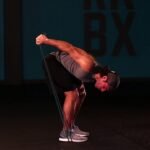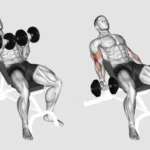Bent-Over Dumbbell Row: Exercise Overview
The bent-over dumbbell row is a powerful compound exercise and a variation of the traditional row, designed to strengthen and develop the muscles of the upper back, including the latissimus dorsi, rhomboids, and trapezius, with secondary engagement of the biceps and core. This movement allows for unilateral work, helping to address strength imbalances between sides while promoting a robust back.
The back thrives on varied training stimuli, so experimenting with grip positions, torso angles, and row variations can optimize muscle growth and strength (Schoenfeld, 2010). As a foundational pulling movement, the bent-over dumbbell row is essential for balanced muscle development and functional strength. It’s a versatile addition to back-focused workouts, upper-body sessions, pull routines, or full-body training programs, suitable for lifters aiming for aesthetics or performance (Wirth et al., 2016).
How to Perform the Bent-Over Dumbbell Row
- Stand with feet hip-width apart, holding a dumbbell in each hand with a neutral grip (palms facing inward).
- Hinge at your hips, pushing them back until your torso is nearly parallel to the floor or slightly higher, maintaining a slight bend in your knees.
- Brace your core to keep your spine neutral—this is your starting position.
- Initiate the movement by driving your elbows back and retracting your shoulder blades, pulling the dumbbells toward your hips or lower chest.
- Pause briefly when your elbows reach or slightly pass your torso, squeezing your back muscles for maximum contraction.
- Lower the dumbbells back to the starting position with control, keeping them close to your body.
- Repeat for the desired number of repetitions.
Tips for Optimal Performance
- Maintain a Neutral Spine: Engage your core to prevent excessive arching or rounding of your back, reducing spinal stress and enhancing back muscle activation (McGill, 2010).
- Control the Movement: Perform the pull and descent slowly to maximize muscle engagement and avoid momentum, which improves effectiveness and reduces injury risk (Schoenfeld, 2016).
- Adjust Head Position: Experiment with a neutral neck (chin tucked) or slightly forward gaze to find the most comfortable and effective position for your posture (Wirth et al., 2016).
- Use a False Grip if Needed: If your biceps overpower the movement, try a thumbless grip to shift focus to the back muscles and reduce arm involvement.
- Allow Shoulder Blade Movement: Let your shoulder blades retract during the pull and protract slightly during the descent to optimize lat and rhomboid engagement.
- Avoid Head Jutting: Keep your head aligned with your spine to prevent neck strain during the row.
- Breathe Properly: Inhale as you lower the dumbbells and exhale as you pull to support core stability and muscle oxygenation.
Strengthening your back with dumbbell rows? See their role in our Ultimate Guide to Muscle Groups for back power.







